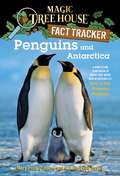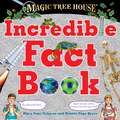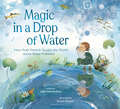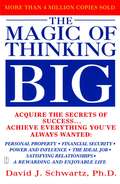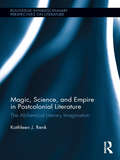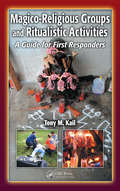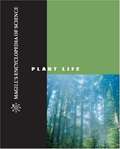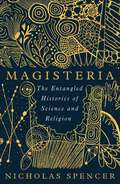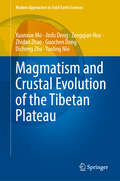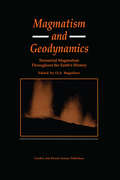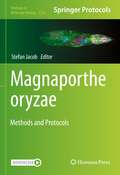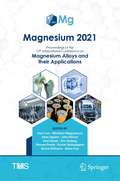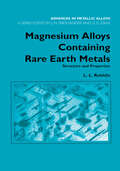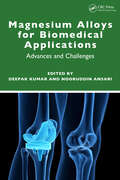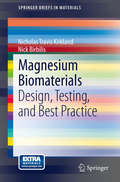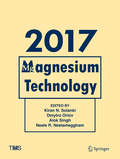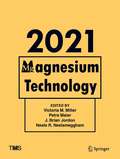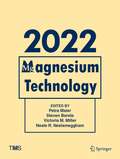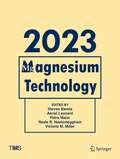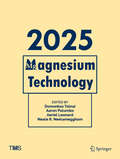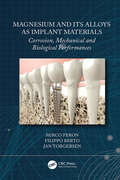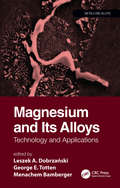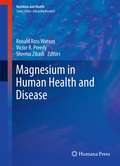- Table View
- List View
Magic Tree House Fact Tracker #18: Penguins and Antarctica
by Mary Pope Osborne Sal Murdocca Natalie Pope BoyceMagic Tree House Research Guides are now Magic Tree House Fact Trackers! Track the facts with Jack and Annie! When Jack and Annie got back from their adventure in Magic Tree House #40: Eve of the Emperor Penguin, they had lots of questions. What do penguins eat? Why do they huddle together in groups? Who won the race to the South Pole? What happens at a research station in Antarctica? Find out the answers to these questions and more as Jack and Annie track the facts. Filled with up-to-date information, photos, illustrations, and fun tidbits from Jack and Annie, the Magic Tree House Fact Trackers are the perfect way for kids to find out more about the topics they discovered in their favorite Magic Tree House adventures.
Magic Tree House Incredible Fact Book: Our Favorite Facts about Animals, Nature, History, and More Cool Stuff! (Magic Tree House (R))
by Mary Pope Osborne Natalie Pope BoyceJack and Annie&’s biggest, most exciting book of facts is their greatest adventure outside the tree house! Jack and Annie have been all over the world in their adventures in the magic tree house. And they&’ve learned lots of incredible facts along the way. Now they want to share them with you! Get ready for a collection of the coolest, weirdest, funniest, grossest, most all-around amazing facts Jack and Annie have ever encountered. With full-color photographs and fun comments from Jack and Annie, this is the essential fact book for all Magic Tree House fans.
Magic in a Drop of Water: How Ruth Patrick Taught the World about Water Pollution
by Julie WinterbottomAn entertaining and gorgeous picture book biography of scientist and environmental hero Ruth Patrick, one of the first to warn about the dangers of pollution.A brilliant scientist and intrepid explorer, the ecologist Ruth Patrick taught the world how to care for the environment. She studied water pollution long before it became a public concern and gave other scientists the tools to do something about it. Born in 1907, Ruth Patrick was one of the only women in her field when she made her breakthrough discovery about biodiversity and the ecosystem of rivers, forever changing how ecologists understand pollution.Lyrically, joyfully written, exquisitely illustrated, and full of fascinating details and a rich afterword and timeline, this STEM biography will inspire readers who love the environment to follow their passion and curiosity.
Magic of Thinking Big
by David SchwartzMillions of people throughout the world have improved their lives using The Magic of Thinking Big. Dr. David J. Schwartz, long regarded as one of the foremost experts on motivation, will help you sell better, manage better, earn more money, and -- most important of all -- find greater happiness and peace of mind. The Magic of Thinking Big gives you useful methods, not empty promises. Dr. Schwartz presents a carefully designed program for getting the most out of your job, your marriage and family life, and your community. He proves that you don't need to be an intellectual or have innate talent to attain great success and satisfaction -- but you do need to learn and understand the habit of thinking and behaving in ways that will get you there. This book gives you those secrets!
Magic, Science, and Civilization
by Jacob BronowskiA compilation of a series of lectures detailing such varied topics as nature, magic and human civilization.
Magic, Science, and Empire in Postcolonial Literature: The Alchemical Literary Imagination (Routledge Interdisciplinary Perspectives on Literature)
by Kathleen RenkThis book examines the ways in which contemporary British and British postcolonial writers in the after-empire era draw connections between magic (defined here as Renaissance Hermetic philosophy) and science. Writers such as Tom Stoppard, Zadie Smith, and Margaret Atwood critique both imperial science, or science used in service to empire, and what Renk calls "imperical science," a distortion of rational science which denies that reality is holistic and claims that nature can and should be conquered. In warning of the dangers of imperical science, these writers restore the connection between magic and science as they examine major shifts in scientific thinking across the centuries. They reflect on the Copernican Revolution and the historic split between magic and science, scrutinize Darwinism, consider the relationship between Victorian science and pseudo-science, analyze twentieth-century Uncertainty theories, reject bio/genetic engineering, call for a new approach to science that reconnects science and art, and ultimately endeavor to bring an end to the imperial age. Overall, these writers forge a new discourse that merges science with the arts and emphasizes a holistic philosophy, a view shared by both Hermetic philosophy and recent scientific theories, such as chaos or complexity theory. Along with recent books that focus on the relationship between contemporary literature and science, this work focuses on contemporary British literature’s critique of science and the ways in which postcolonial literature addresses the relationship between magic, science, and empire.
Magico-Religious Groups and Ritualistic Activities: A Guide for First Responders
by Tony M. KailMore than just a litany of artifacts, rituals, and symbols, this valuable book provides a cultural bridge for emergency responders. It places the information in a relevant context and offers crucial keys to communication, assessment, and treatment in culturally sensitive situations. Beginning with the importance of trans-cultural communication, the book separates fact from fantasy regarding Neo-Paganism, Santeria, Bantu religion (Palo Mayombe), Voodoo, and Curanderismo. Promoting functional cultural competency, this book provides the tools to properly assess situations, open lines of communication, protect cultural diversity, and provide effective emergency treatment.
Magill's Encycopedia of Science: Plant Life Volume 1
by Bryan D. NessThis encyclopaedic reference provides information about the scientific principles, the classification, and the members of the plant kingdom.
Magisteria: The Entangled Histories of Science & Religion
by Nicholas SpencerMost things you &‘know&’ about science and religion are myths or half-truths that grew up in the last years of the nineteenth century and remain widespread today. The true history of science and religion is a human one. It&’s about the role of religion in inspiring, and strangling, science before the scientific revolution. It&’s about the sincere but eccentric faith and the quiet, creeping doubts of the most brilliant scientists in history – Galileo, Newton, Faraday, Darwin, Maxwell, Einstein. Above all it&’s about the question of what it means to be human and who gets to say – a question that is more urgent in the twenty-first century than ever before. From eighth-century Baghdad to the frontiers of AI today, via medieval Europe, nineteenth-century India and Soviet Russia, Magisteria sheds new light on this complex historical landscape. Rejecting the thesis that science and religion are inevitably at war, Nicholas Spencer illuminates a compelling and troubled relationship that has definitively shaped human history.
Magmatism and Crustal Evolution of the Tibetan Plateau (Modern Approaches in Solid Earth Sciences #25)
by Zengqian Hou Xuanxue Mo Jinfu Deng Zhidan Zhao Guochen Dong Dicheng Zhu Yaoling NiuThis book presents a comprehensive coverage of the magmatic and crustal evolution of the Tibetan Plateau through time, based mainly on the recent data and observations of the authors. It provides extensive geochemical, isotopic and geochronological datasets to better constrain the geodynamic evolution of the highest and thickest orogenic plateau in the world. It is a unique and original contribution to our understanding of the geology and landscape of the “roof of the world” in an integrated and multi-disciplinary approach. All chapters in the book are process-oriented and data-rich, and reflect the most recent knowledge and information on the Tibetan Plateau. All five authors of the book have worked extensively in Tibet and in the adjacent areas over the years. Their familiarity with both the geology of Tibet and all the research done there by different scientific teams during the last 30 years are a major driving force behind this book.
Magmatism and Geodynamics: Terrestrail Magmatism Throughout the Earth's History
by O. A. BogatikovMagnatism is the only true endogenic process for generating new material on the Earth's surface. Obviously, magmatism and tectonic movements are reflections of geodynamics, that is, physical processes which occur in deep-seated environments. What are the interrelationships between magmatism and tectronics? How did the character of terrestrial magmatism change through time and are there any irregularities in this process?
Magnaporthe oryzae: Methods and Protocols (Methods in Molecular Biology #2356)
by Stefan JacobThis volume highlights molecular methods to study the phytopathogenic rice blast fungus Magnaporthe oryzae. Chapters in this book cover the history, development, and evolution of the pathogen; molecular methods to increase the knowledge of the biology, genetic, and metabolic diversity of the pathogen; and the pathogen’s adaptability. Written in the highly successful Methods in Molecular Biology series format, chapters include introductions to their respective topics, lists of the necessary materials and reagents, step-by-step, readily reproducible laboratory protocols, and tips on troubleshooting and avoiding known pitfalls. Cutting-edge and comprehensive, Magnaporthe oryzae: Methods and Protocols is a valuable resource for any scientist or researcher interested in learning more about this developing field.
Magnesium 2021: Proceedings of the 12th International Conference on Magnesium Alloys and Their Applications (The Minerals, Metals & Materials Series)
by Bruce Williams John Allison Warren Poole Alan Luo Eric Nyberg Sean Agnew Mihriban Pekguleryuz Karl Kainer Kumar Sadayappan Steve YueThis collection from the 12th International Conference on Magnesium Alloys and Their Applications (Mg 2021)—the longest running conference dedicated to the development of magnesium alloys—covers the breadth of magnesium research and development, from primary production to applications to end-of-life management. Authors from academia, government, and industry discuss new developments in magnesium alloys and share valuable insights. Topics in this volume include but are not limited to the following: Primary production Alloy development Solidification and casting processes Forming and thermo-mechanical processing Other manufacturing process development (including joining and additive manufacturing) Corrosion and protection Modeling and simulation Structural, functional, biomedical, and energy applicationsAdvanced characterization and fundamental theoriesRecycling and environmental issues
Magnesium Alloys Containing Rare Earth Metals: Structure and Properties (Advances in Metallic Alloys)
by L.L. RokhlinMagnesium-based alloys containing rare-earth metals are important structural materials, as they combine low density with high-strength properties. This makes them particularly attractive for industry, especially in cases where the low weight of constructions is critical, as in aircraft and space apparatus construction. One of the remarkable feature
Magnesium Alloys as Degradable Biomaterials
by Yufeng ZhengMagnesium Alloys as Degradable Biomaterials provides a comprehensive review of the biomedical applications of biodegradable magnesium and its alloys. Magnesium has seen increasing use in orthopedic and cardiovascular applications over the last decade, particularly for coronary stents and bone implants.The book discusses the basic concepts of biodeg
Magnesium Alloys for Biomedical Applications: Advances and Challenges
by Deepak Kumar Nooruddin AnsariMagnesium alloys have enormous potential for use in biomedical implants. Magnesium Alloys for Biomedical Applications delves into recent advances and prospects for implementation and provides scientific insights into current issues posed by Mg alloy materials. It provides an overview of research on their mechanical and tribological characteristics, corrosion tendencies, and biological characteristics, with a particular emphasis on biomedical implants. Details the fundamentals of Mg alloys as well as necessary surface modifications of Mg alloys for biomedical use. Discusses emerging Mg alloys and their composites. Covers mechanical, tribological, and chemical properties, as well as fatigue and corrosion. Highlights emerging manufacturing methods and advancements in new alloy design, composite manufacturing, unique structure design, surface modification, and recyclability. Helps readers identify appropriate Mg-based materials for their applications and select optimal improvement methods. Summarizes current challenges and suggests a roadmap for future research. Aimed at researchers in materials and biomedical engineering, this book explores the many breakthroughs achieved with these materials and where the field should concentrate to ensure the development of safe and reliable Mg alloy-based implants.
Magnesium Biomaterials
by Nicholas Travis Kirkland Nick BirbilisMagnesium Biomaterials provides a succinct up-to-date overview of Magnesium biomaterial development, critically examines the types of in vitro experiments that may be performed, and investigates the numerous variables that affect Magnesium biodegradation when undertaking these experiments. This work also discusses the direction in which current Magnesium biomaterial development is heading and the necessary steps for future development of this field. Information is drawn from numerous multi-disciplinary sources to provide a coherent and critical overview. Magnesium Biomaterials is ideal for researchers in the area of bio-Mg, companies interested in exploring their own alloys, and for researchers working with other biodegradable materials who are seeking a cross-platform understanding of material performance.
Magnesium Technology 2017
by Alok Singh Neale R. Neelameggham Kiran N. Solanki Dmytro OrlovThe Magnesium Technology Symposium, the event on which this collection is based, is one of the largest yearly gatherings of magnesium specialists in the world. Papers represent all aspects of the field, ranging from primary production to applications to recycling. Moreover, papers explore everything from basic research findings to industrialization. Magnesium Technology 2017 covers a broad spectrum of current topics, including alloys and their properties; cast products and processing; wrought products and processing; forming, joining, and machining; corrosion and surface finishing; ecology; and structural applications. In addition, there is coverage of new and emerging applications.
Magnesium Technology 2021 (The Minerals, Metals & Materials Series)
by Neale R. Neelameggham J. Brian Jordon Victoria M. Miller Petra MaierThe Magnesium Technology Symposium, the event on which this collection is based, is one of the largest yearly gatherings of magnesium specialists in the world. Papers represent all aspects of the field, ranging from primary production to applications to recycling. Moreover, papers explore everything from basic research findings to industrialization. Magnesium Technology 2021 is a definitive reference that covers a broad spectrum of current topics, including novel extraction techniques; primary production; alloys and their production; thermodynamics and kinetics; cast products and processing; wrought products and processing; forming, joining, and machining; corrosion and surface finishing; structural applications; degradation and biomedical applications; and several others.
Magnesium Technology 2022 (The Minerals, Metals & Materials Series)
by Neale R. Neelameggham Victoria M. Miller Petra Maier Steven BarelaThe Magnesium Technology Symposium at the TMS Annual Meeting & Exhibition is one of the largest yearly gatherings of magnesium specialists in the world. Papers represent all aspects of the field, ranging from primary production to applications and recycling. Moreover, papers explore everything from basic research findings to industrialization. Magnesium Technology 2022 is a definitive reference that covers a broad spectrum of current topics, including novel extraction techniques; primary production; alloys and their production; integrated computational materials engineering; thermodynamics and kinetics; plasticity mechanisms; cast products and processing; wrought products and processing; forming, joining, and machining; corrosion and surface finishing; fatigue and fracture; dynamic response; structural applications; degradation and biomedical applications; emerging applications; additive manufacturing of powders; and recycling, ecological issues, and life cycle analysis.
Magnesium Technology 2023 (The Minerals, Metals & Materials Series)
by Neale R. Neelameggham Victoria M. Miller Petra Maier Steven Barela Aeriel LeonardThe Magnesium Technology Symposium at the TMS Annual Meeting & Exhibition is one of the largest yearly gatherings of magnesium specialists in the world. Papers represent all aspects of the field, ranging from primary production to applications and recycling. Moreover, papers explore everything from basic research findings to industrialization. Magnesium Technology 2023 is a definitive reference that covers a broad spectrum of current topics, including novel extraction techniques; primary production; alloys and their production; integrated computational materials engineering; thermodynamics and kinetics; plasticity mechanisms; cast products and processing; wrought products and processing; forming, joining, and machining; corrosion and surface finishing; fatigue and fracture; dynamic response; structural applications; degradation and biomedical applications; emerging applications; additive manufacturing of powders; and recycling, ecological issues, and life cycle analysis.
Magnesium Technology 2025 (The Minerals, Metals & Materials Series)
by Neale R. Neelameggham Aeriel Leonard Domonkos Tolnai Aaron PalumboThe Magnesium Technology Symposium at the TMS Annual Meeting & Exhibition is one of the largest yearly gatherings of magnesium specialists in the world. Papers represent all aspects of the field, ranging from primary production to applications and recycling. Moreover, papers explore everything from basic research findings to industrialization. Magnesium Technology 2025 is a definitive reference that covers a broad spectrum of current topics, including novel extraction techniques; primary production; alloys and their production; integrated computational materials engineering; thermodynamics and kinetics; plasticity mechanisms; cast products and processing; wrought products and processing; forming, joining, and machining; corrosion and surface finishing; fatigue and fracture; dynamic response; structural applications; degradation and biomedical applications; emerging applications; additive manufacturing of powders; and recycling, ecological issues, and life cycle analysis.
Magnesium and Its Alloys as Implant Materials: Corrosion, Mechanical and Biological Performances
by Mirco Peron Filippo Berto Jan TorgersenDespite their tremendous potential, Mg and its alloys are not yet used in biomedical applications. This book aims to provide scientific insights into the challenges of the materials, and give an overview of the research regarding their mechanical properties, corrosion behaviour and biological performances. The authors intend to put the reader into the position to accurate discern the proper Mg-based material for his/her applications and to choose the proper improvement strategy to his/her cause. To this aim, the manuscript is structured as follow: in Section 2, the main challenges hampering the use of magnesium in biomedical applications and the common improvement strategies are listed. In Section 3, the most investigated Mg alloys are reported in separate sub-sections, detailing their mechanical properties, corrosion behaviour and biotoxicity. High-pure and ultra-high-pure Mg, Al-based Mg alloys, Zn-based Mg alloys, Ca-based alloys and RE-based Mg alloys have been considered. In Section 4, the alloys’ performances with respect to the challenges is summarized providing the reader with useful information and suggestions on the potentially most suited choice. Finally, in Section 5, an outlook portraying the authors’ opinion of the future development of the field will be provided. This book will allow biomedical engineers, surface scientists, material scientists, implant manufacturers and companies working on implant approval an overview of the state-of-the-art technologies adopted so far to overcome the drawbacks of Mg for biomedical applications. Particular emphasis is put on explaining the link between mechanical, corrosion and biocompatible properties of Mg and its alloys as well as their pros and cons. In doing so, the authors intend to put the reader into the position to accurate discern the proper Mg-based material for his/her applications and to choose the proper improvement strategy to his/her cause.
Magnesium and Its Alloys: Technology and Applications (Metals And Alloys Ser.)
by Leszek A. Dobrzański, George E. Totten and Menachem BambergerMagnesium and Its Alloys: Technology and Applications covers a wide scope of topics related to magnesium science and engineering, from manufacturing and production to finishing and applications. This handbook contains thirteen chapters, each contributed by experts in their respective fields, and presents a broad spectrum of new information on pure magnesium, magnesium alloys, and magnesium matrix MgMCs composites. It covers such topics as computational thermodynamics, modern Mg-alloys with enhanced creep or fatigue properties, cutting-edge approaches to melt treating (grain refinement, micro-alloying, and the resulting solidification and growth), coatings, surface engineering, environmental protection (recycling and green energy storage and production), as well as biomedical applications. Aimed at researchers, professionals, and graduate students, the book conveys comprehensive and cutting-edge knowledge on magnesium alloys. It is especially useful to those in the fields of materials engineering, mechanical engineering, manufacturing engineering, and metallurgy.
Magnesium in Human Health and Disease
by Victor R. Preedy Ronald Ross Watson Sherma ZibadiMagnesium is an essential mineral which is required for growth and survival of humans. Since magnesium is a mineral and not synthesizable it must be obtained through dietary foods and/or supplements. Magnesium in Human Health and Disease reviews the benefits of magnesium supplementation to reach recommended intakes as well as provides new research that suggests how reaching levels above the recommended intakes can promote health and treat various diseases. Magnesium deficiency can cause low serum potassium and calcium levels, retention of sodium, and low circulating levels of regulatory hormones. These changes in nutrients cause neurological and muscular symptoms such as tremor and muscle spasms. Further magnesium deficiency causes loss of appetite, nausea, vomiting, personality changes and death from heart failure. Causes of magnesium deficiency include alcohol abuse, poorly controlled diabetes, excessive or chronic vomiting and/or diarrhea. Thus the effects of inadequate and deficient intakes or levels of magnesium is critical to health and are reviewed by the expert clinicians in this book. Magnesium in Human Health and Disease provides the most current research to support the potential benefits or lack thereof for normal and high supplementation with magnesium. Animal model research and early human trials are reviewed to document other disease states such as hypertension, cholesterol level, type 2 diabetes and cardiovascular disease that would benefit from increased magnesium.
